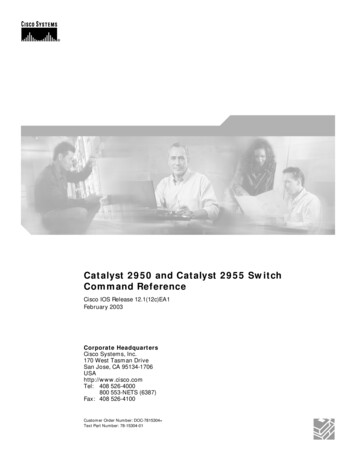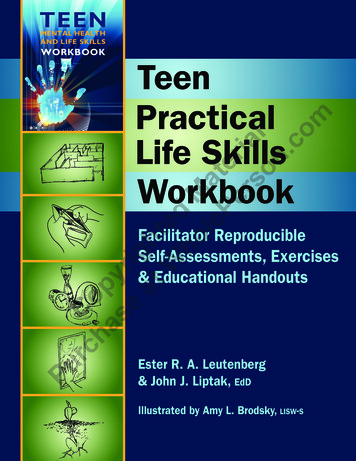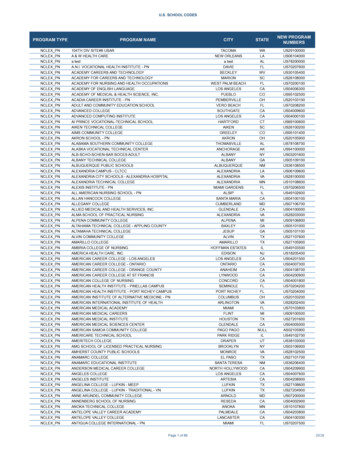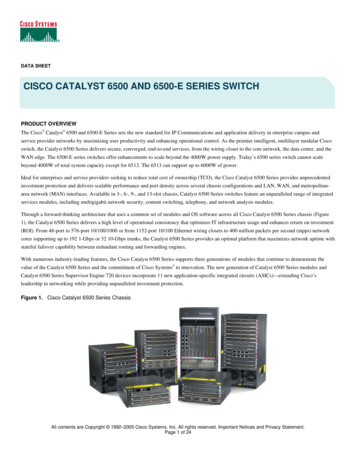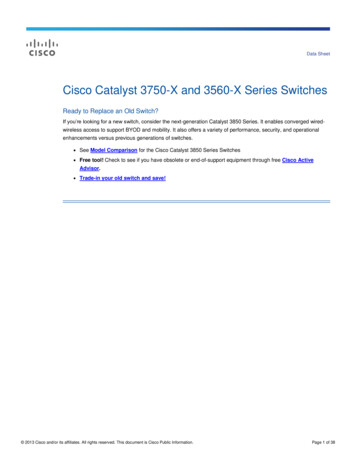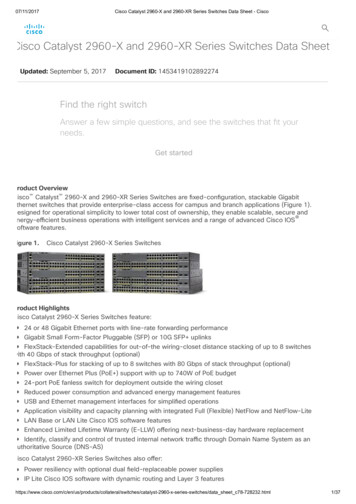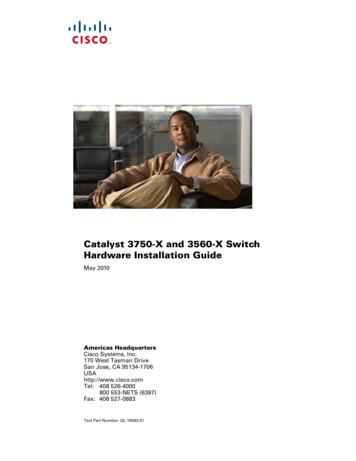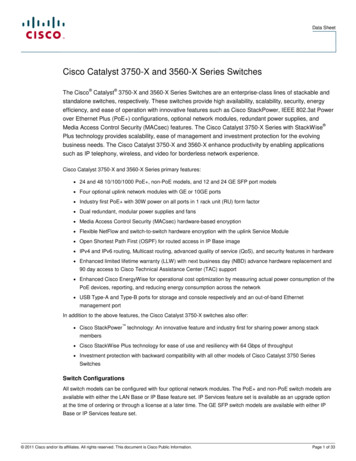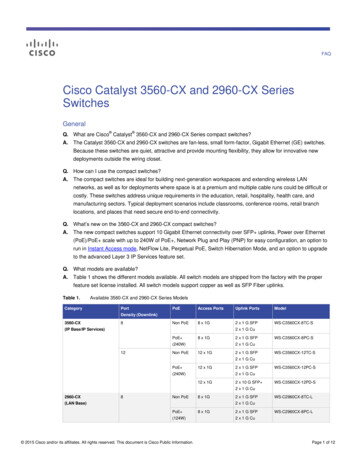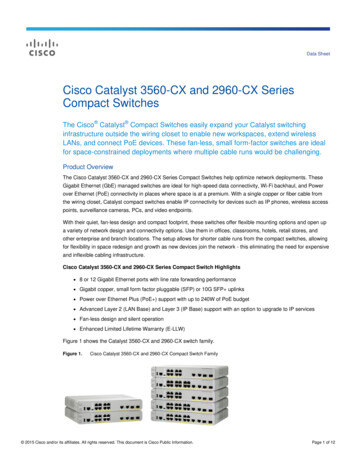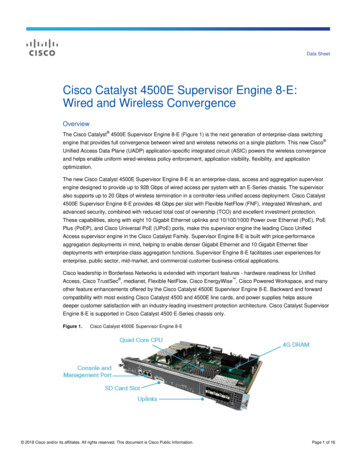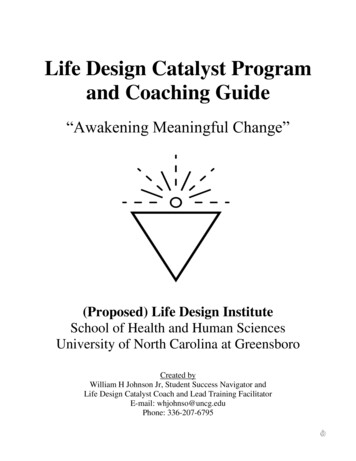
Transcription
Life Design Catalyst Programand Coaching Guide“Awakening Meaningful Change”(Proposed) Life Design InstituteSchool of Health and Human SciencesUniversity of North Carolina at GreensboroCreated byWilliam H Johnson Jr, Student Success Navigator andLife Design Catalyst Coach and Lead Training FacilitatorE-mail: whjohnso@uncg.eduPhone: 336-207-67950
Table of ContentsWelcome2Life Design Catalyst Manifesto3Why the Life Design Catalyst Program? Why Now? (Web Links)4Overview of Life Design Catalyst Program6Life Design Catalyst Program “in the World”9Life Design Catalyst Program Models11So, Why Am I in College? An Advising Request from a 21st Century Student13Life Design Catalyst Coaching Program14The Future of Advising and Coaching17LDC Group Coaching Model18Getting Started: Developing a Coaching Program20Life Design Catalyst Coaching Questions21Coaching Tools Coaching Information: Client/Student Intake Form26 Coaching Assessment: My Life Self-Assessment27 Coaching Conversation: Find Your SPARCK Questions/Purpose Statement29 Coaching Accountability: Life Design 1-Month Challenge30Group Coaching Course Syllabus: HHS125: Design Your Life I –What Could I Do With My Life31Group Coaching Poster Examples My Life Story and Major/Career/Calling Exploration Posters34 Calling Connection Mind Map and Personal Charter Posters35 Current State vs My Best Self and You, The Superhero Posters36Course Evaluation Results for HHS12537About the University of North Carolina at Greensboro andthe School of Health and Human SciencesContact Information38391
Welcome to the world of Life Design Catalysts!It is very exciting that you will join us on this journey! The Life Design Catalyst Program was“officially” created in 2014, although many of the tools and activities for the program have been aroundfor over 25 years! You will be a part of a growing community of revolutionaries inspired to help youngpeople optimize their lives and actualize their potential to become the best version of themselves, inorder to serve something bigger than themselves and make the world a better place – all through theexploration of purpose (“Who do I want to be?”) and meaning (“What am I here to do?”).In July 2007, I was hired as the Student Success Coordinator in the School of Health and HumanPerformance to coordinate academic advising. However, I was given a specific mandate to createsomething completely different than what was being offered by the other Colleges/Schools on campus.In that first year, I realized that I had to come up with a more efficient use of my time, since I could notmeet with the 1,500 undergraduate students in the School of HHP. In 2008, I was granted theopportunity to teach two sections of HHP125: Personal and Academic Success in Health and HumanPerformance. This one-credit course was limited to 20 students and met once a week for 50 minutes.Instead of a focus on strategies to be successful in college, this course focused on life work – the skillsand knowledge necessary to be successful in life.After five years, 26 sections, and 500 students, the “Make College Matter” Program was chosen as oneof nine (out of 75) Best Advising Practices by the Bill and Melinda Gates Foundation. In 2014, thename was changed to Life Design Catalyst Program, since much of the coursework was geared towardsliving a purposeful and meaningful life, not just being successful in college. Also, in 2014, we createdthe Life Design Catalyst Coach Training Program (then called the Purpose and Vision Navigator CoachTraining Program) to share Life Design work with those interested in incorporating values, purpose,meaning, and vision as a foundation for student success. Over the course of nine trainings at UNCG(since June 2014) and five trainings off-campus, we have now trained over 400 coaches at 70-plusinstitutions of higher education, as well as community organizations, professional associations, and lifecoaching entrepreneurs. And just this past May (2018), the LDC Program was recognized by theNational Academic Advising Association as a recipient of a Certificate of Merit as an OutstandingAdvising Program.Thank you for your interest in being a part of this movement! It is my intention to generously share myknowledge and resources with you so that you can find fun and inspiring ways to do the work you arecalled to do. With your service, we can truly transform the way young people view life, moving from astate of self-actualization to a state of self-transcendence! Life Design work is not only important forthem and for you, but it’s important for our country – and for our humanity! We urge you to take part inour sessions at conferences and our trainings and workshops to find your “why,” so that you can serveprofoundly and impact the lives of many others! We look forward to working with you!With immense gratitude Bill Johnson, Managing DirectorLife Design Institute2
Life Design Catalyst Manifesto“Our job in this lifetime is not to fit into some mold that others have determined is best for us.Our job is to find out who we already are – and become it.” - Steven Pressfield-------------------------This is your life. Own it.At the start of each day, ask yourself: “What do I need to do to give a great day today?”Don't let your past define you; recognize it, accept it and move on from it.Take 100% personal responsibility for all choices, actions, and decision you make. Every day.Seek to find who you want to be and what you are here to do. Find YOUR "Why.Let exploration, imagination, creativity and play fuel your curiosity.When an idea inspires you and fires you up, don’t wait. Act on it right away.Be the most helpful person you know by sharing your gifts with the world.Create a compelling, inspiring vision for your future. Then, go do it.Life’s greatest moments reside in the gap between where you are and where you want to be.For each moment, choose whether you want to move forward into growth or backward into safety.Don’t be afraid to fail; see it as a life lesson, telling you to move in a different direction.Success doesn’t happen without passion and deliberate practice. Perseverance is key.Challenge yourself and get out of your comfort zone; it’s the only way you’ll grow.Be willing to ask for help; don’t feel like you have to tackle this journey alone.Connect with people who will support you, help you grow, and, every once in a while, kick you in the butt.Know yourself intimately. Live with authenticity and integrity. Become the best version of yourself.Essential disciplines to thrive: move your body, ease your mind, embrace your health.Always Love – love your work, love your people, and love yourself.Find a way to connect with your beautiful and worthy self. Allow yourself to be seen.At the end of the day, ask yourself: “Did I add value today?”Write Your Story. Be Your Hero.3
Why the Life Design Catalyst Program? Why Now?Data on Higher Education and the American Workplace(last updated 6/5/2018)The Life Design Catalyst Program was created to address several issues pertinent to education and work. TheProgram, which includes the Life Design Catalyst Coaching Program, is motivated to solve these specific issues:1. Offer students meaningful option, since most don’t know what they want to do.2. Provide support/guidance early on for those students in college, regardless of whether they complete theirdegree or not.3. Explore purpose and meaning at a deeper level, since young people crave help in this process.4. Prepare for an unknown world of work, due to a rapidly changing marketplace.The links below provide a glimpse of the issues we aim to solve in the Program: 80% - percentage of students who don't know what to do in college. (Major Decisions /choosing-one-college-major-out-of-hundreds.html) 75% - percentage of students who change their major at least once. (The Developmental Disconnect inChoosing a Major: Why Institutions Should Prohibit Choice until Second Year sing-major/) 41% - percentage of students who don't graduate from 4-year college in 6 years: 59% graduation rate(National Center for Education Statistics - https://nces.ed.gov/programs/coe/indicator ctr.asp) 71% - percentage of students who don't graduate from 2-year college in 3 years: 29% graduation rate(National Center for Education Statistics - https://nces.ed.gov/programs/coe/indicator ctr.asp) 50% - percentage of students who don't graduate from UNCG in 5 years: 50% graduation rate (Universityof North Carolina System ewer/guest.jsp?appSwitcherDisabled true&reportViewOnly true&reportPath /UNG/External%20Content/Reports&reportName Freshman performance) 45% - percentage of students who don't graduate from UNCG in 6 years: 55% graduation rate.(University of North Carolina System ewer/guest.jsp?appSwitcherDisabled true&reportViewOnly true&reportPath /UNG/External%20Content/Reports&reportName Freshman performance) 72% - percentage of students at UNCG in 2015 who graduated with college debt; average debt 26,123- does NOT include those that do not graduate. (Institute for College Access and Success http://ticas.org/posd/map-state-data) 36 million - number of adults with college credit and not degree in U.S. (Graduate Network http://graduate-network.org/) 21% - percentage of adults in Guilford County have college credit and no degree: 67,000 adults (LuminaFoundation Invests in Degrees Matter - tioninvests-in-degrees-matter/) 5.6% - percentage of college graduates who are unemployed; 12.6% - percentage of college graduateswho are underemployed (in jobs that don't require a college school degree); 17.9% - percentage of highschool graduates who are unemployed 33.7% - percentage of high school graduate who areunderemployed (in jobs that don't require a degree). (The Class of 2016, Economic Policy Institute http://www.epi.org/publication/class-of-2016/) 40-50% - percentage of potential independent workers (freelance, consultants, etc) by 2020 (Intuit 2020Report - tuit/futureofsmallbusiness/intuit 2020 report.pdf) 90% - percentage of potential independent workers by 2040 (As shared by Donald F. Kuratko, Professorof Entrepreneurship, Indiana University at the 2016 Experiential Classroom Workshop, University ofFlorida) 50% - percentage of occupations today will no longer exist by 2025 (Fast Forward 2030: The Future ofWork and the Workplace: k) 2.6% - percentage of those between ages of 15 to 34 self-employed in 2014, down from 3.9% in 1988. In2014, for ages 35 to 54, 8.2% are self-employed and for ages 55 and over, 6.4% are self-employed. (The4
Missing Millennial Entrepreneurs, US Small Business Administration illenial IB.pdf)68% - percentage of employees in the US either not engaged (50.8%) or actively disengaged (17.2%) intheir work. (Gallup, Inc. - ment-stagnant2015.aspx)11% - percentage of college graduates thriving in the five areas of well-being: purpose, social, financial,community, and physical. However, 17% of college graduates not thriving in ANY of the five areas ofwell-being. (Great Jobs, Great Lives, The 2014 Gallup-Purdue Index Report alluppurdueindex-report-2014.pdf)36% - percentage of adults who pursued or completed a postsecondary degree would chose a differentfield of study. (Gallup, Inc. and Strada Education Network - e-least-one-education-decision.aspx)31% - percentage of students expressed interest in replacing declaring a “major” with declaring a“purpose” and select courses based on obtaining knowledge that would help me move in that direction.(Purpose in Higher Education, Imperative raduates/#54d0bc31502c)85% - percentage of purpose-led companies that showed positive growth vs. 58% - percentage of nonpurpose led companies that showed positive growth.(2016 Workforce Purpose Index, Imperative https://cdn.imperative.com/media/public/Global Purpose Index 2016.pdf)47% - percentage of college students that are purpose-oriented. (Purpose in Higher Education, Imperative- raduates/#54d0bc31502c)76% - percentage of college students on a search for meaning and purpose in life (UCLA) l Life College Students Full Report.pdfOther interesting articles Freelancers predicted to become the U.S. workforce majority within a decade, with nearly 50% ofmillennial workers already freelancing, annual “Freelancing in America” study finds g-in-america-2017/ Discover Your Passion and Purpose - ose/ "Envisioning the Future" by Marc Lowenstein %20Conference/documents/Lowenstein proof.pdf5
Life Design Catalyst (LDC) ProgramSchool of Health and Human SciencesOverviewIntroductionThe Life Design Catalyst Program provides the SPARCK to empower students to answer life’s biggest question: Whatshould I do with my life? The mission of the Life Design Catalyst Program is to inspire students – young and old – toacquire the knowledge and develop the skills essential to optimize their lives, actualize their potential, and become thebest version of themselves in order serve something bigger than themselves and make a positive contribution to theworld.Life Design Catalyst Program Principles Provides a content-based group coaching process (“Coaching to Know, Coaching to Grow”), designedspecifically to engage in meaningful conversations AND to take action towards personal transformation. Views the exploration of purpose (“Who am I meant to be?”) and meaning (“What am I here to do?”) as thefoundation for student/personal development and student/life success. Engaged in a process where learning is focused on self-actualization (becoming the best version of yourself)and self-transcendence (utilizing the best of yourself for something bigger than yourself). Incorporates features of design thinking as a process in designing one’s life. Guided by concept of self-expertise – that YOU are the expert on YOU. Empowers students to take control of their lives through self-directed learning and self-designed experiences. Recognizes that Better Character Better People Better People Better Students. Subscribes to the belief that in every moment of the day you have an opportunity choose whether to moveforward into growth ( 1) or backward into safety (-1). Promotes the development of the entrepreneurial spirit by: (1) becoming deeply engaged in and committed topersonally rewarding purposeful, passionate goals; (2) being intentional and resilient in taking calculated risksto create value and generate meaningful results despite adversity and obstacles; and (3) using creativity andresourcefulness to design a better life and a better future for yourself and for others.Life Design Simple Rules for Success Know Yourself. Serve Profoundly. Find Your Right Pond.LDC Motto: Find Your Why, Find Your Way.Design Your Life CoursesFirst-YearSecond Year HHS125: What Could I Do With My Life (1 cr) HHS250: Purpose-Driven Entrepreneurship (3 cr) HHS135: Redesign a Life You’ll Love (1 cr) HHS275: Entrepreneurial Personal Branding (3 cr)HUGE bonus for students: No books required for ANY of our courses! We’ve created all materials for our classes – freeaccess to all students enrolled in our classes. Proponents of Open Education Resources (OER) Initiative.Design Your Life First-Year Course Curriculum (Academic Year 2017-18)HHS125: What Could I Do With My Life (Fall)Weekly ActivitiesIntroduction to Breathing MeditationKick-Ass Questions About LifePersonal ResponsibilityI Am StatementsMy Life Story WorksheetPersonality Type AssessmentPersonal Core and Desired Work ValuesHHS135: Redesign a Life You’ll Love (Spring)Weekly ActivitiesGratitude ProjectRandom Act of seDaily Practice/Life S.A.V.E.R.SWriting Your Eulogy6
Character and Engagement StrengthsLollipop Moments and Seven Word Life MottoFind Your Spark Questions and Purpose StatementMeaningful Work Statement and Personal ManifestosVision of Best Self Twitter PitchI Am PoemPersonal SuperpowersFind Your People/Build Your TribeLife WordPosters/PresentationsMy Life StoryMajor/Career/Calling ExplorationPersonal CharterPosters/PresentationsThe Big 3: Current State vs. Ideal StateYou, the SuperheroMy Meaningful LifeDataSince the inception of the HHS125 course in Fall Semester, 2008, we have tracked students’ graduation and retentionrates. The chart below shows that students who enroll in the “HHS125: Design Your Life I - What Could I Do WithMy Life” course in the Fall Semester of their first semester are retained from their first to second year AND theygraduate from UNCG at a higher rate than those students who do not enroll in the HHS125 course in the Fall Semester.(Note: UNCG Retention and Graduation Rate Data obtained from UNC-GA Data Dashboard and/or UNCG Office ofInstitutional Research Common Data Set web site.)Fall to Fall Retention RateHHS125UNCGFall 2008 to Fall 200978.9% (30)77.0%Fall 2009 to Fall 201075.6% (31)77.0%Fall 2010 to Fall 201176.9% (30)75.6%Fall 2011 to Fall 201281.1% (30)75.8%Fall 2012 to Fall 201365.3% (32)73.6%Fall 2013 to Fall 20141,275.0% (66)78.1%Fall 2014 to Fall 20153,484.9% (101)77.0%Fall 2015 to Fall 201683.5% (111)76.0%Fall 2016 to Fall 2017582.5% (221)76.0%Fall 2017 to Fall 2018TBDTBDTotal (652/812)80.3%76.2% est.(Number in parentheses are actual number of first year studentsretained)Total Enrollment in HHS125 (Fall Semester)Fall 2008: 2 sections, 40 students (38 1st year)Fall 2009: 3 sections, 56 students (41 1st year)Fall 2010: 3 sections, 65 students (39 1st year)Fall 2011: 3 sections, 66 students (37 1st year)Fall 2012: 3 sections, 73 students (49 1st year)Fall 2013: 8 sections, 111 students (88 1st year)Fall 2014: 10 sections, 170 students (119 1 st year)Fall 2015: 10 sections, 193 students (133 1 st year)Fall 2016: 17 sections, 320 students (268 1 st year)Fall 2017: 20 sections, 374 students (TBD)(Number in parentheses are actual number of first yearstudents enrolled in HHS125 in the Fall Semester)-------------------------Graduation Rates (5-year)Fall 2008 class (25/38)Fall 2009 class (23/41)Fall 2010 class (19/39)Fall 2011 class (21/37)Fall 2012 class (19/49)Total 9.7%50.4% est.Enrollment in HHS135 (Spring Semester)Spring 2014: 2 sections, 13 students (xx 1st year)Spring 2015: 3 sections, 35 students (xx 1st year)Spring 2016: 3 sections, 33 students (xx 1st year)Spring 2017: 4 sections, 62 students (xx 1st year)Spring 2018: TBDGraduation Rates (6-year)Retention Rate: Students enrolled in both HHS125Fall 2008 class (28/38)73.7%55.0%and HHS135 during their first-year: 90.6%Fall 2009 class (25/41)61.0%56.0%Fall 2010 class (22/39)56.4%54.0%Fall 2011 class (22/37)59.5%53.1%Total (107/155)62.6%54.5% est.1Reviewing transcripts of the 66 retained students in Fall, 2013, 37 (42%) have already graduated by December2017 (4.5 years or less); an additional 17 are on track to graduate in May 2018 - which means that 61.4% are ontrack to graduate in 5 years or less.2Fall 2013 was the introduction to the Life Design Catalyst Coaching process and curriculum to HHS125 students.3Reviewing transcripts of the 101 retained students in Fall, 2014, 95 of the 101 (79.8%) are still enrolled and ontrack to graduate in 5 years or less (May 2019).4Fall 2014 was the introduction of Life Design Poster Projects and Presentations in the HHS125 courses.5Fall 2016 was the first time all HHS125 instructors followed a common Life Design Catalyst curriculum (posted on-linethrough Canvas) for the HHS125 course.7
Student Learning Outcomes (Fall 2017)We have also obtained student responses to the Student Learning Objectives outlined in the syllabus for the HHS125course from the 2017 Fall Semester. The information below is the students’ responses results to specific questionsregarding the learning objectives, the effectiveness, and the overall value of the HHS125 course. The percentagesindicate responses of students that chose either "Strongly Agree" or "Agree" to each of the questions, out of 328 totalresponses. Many of the responses below are most pertinent to the mission of HHS125 – which is to help studentsidentify how they want to serve the world in a meaningful way, then connect that declaration with their major and theirvision for the future. 92.7% - This course helped me understand my personality, my strengths, and my values. 86.0% - This course helped me understand my meaningful work - how I plan to serve others. 86.9% - This course helped to clarify my goals and dreams, and create a vision for my future. 74.4% - This course helped me decide on my major or helped me clarify that I am in the right major. 87.8% - This course provided me with knowledge that could help me be successful in life. 82.0% - I believe that I can make better decisions about my life and my future now that I have completed thiscourse. 80.0% - I have a much better understanding of who I want to be and what I’m here to do now that I’vecompleted this course. 84.2% - I found the “Major/Career/Calling Exploration” Poster or the Calling Connection Mind Map useful increating a plan of action in college and/or after college. 70.4% - I enjoyed having meditation/quiet time at the beginning of every class. 79.2% - I appreciated the opportunity to interact with my classmates during class each week. 76.5% - I believe a course like this should be a required course for ALL new students.Life Design Catalyst Coach Training Program /) First Training was held June 2014. Trainings on campus (at UNCG) are typically in May and December. Asof May 2018, we have facilitated NINE Coach Trainings at UNCG. Life Design Catalyst Coach Training Program is a content-based program. Participants will engage incoaching, reflection, and personal development activities. Training is HIGHLY INTERACTIVE. Life Design Catalyst Coaching Model allows for flexibility and adaptability in coaching and advising settings. Seen as professional development through personal exploration and reflection. Trained over 400 Life Design Catalysts Coaches from 70 different colleges and universities internationally. Provided 1-, 2-, 3-, and 4-day Life Design Catalyst Trainings (Coach Training and/or FYE CourseDevelopment) at several 2-year and 4-year institutions across the country.Contact InformationLife Design Catalyst Program Lead Facilitator (“The Visionary”) Bill Johnson, whjohnso@uncg.edu, 336-207-6795Life Design Catalyst Program Facilitators (“The Crusaders”) Megan Delph Cayton, mcdelph@uncg.edu William “Scott” Holloway, wshollow@uncg.eduLDC Program Support Facilitators (“The Advocates”) Jennifer Clark, jdaustin@uncg.edu Dr. Kathleen Williams, k willia@uncg.eduLDC (Former) Undergraduate Student Coaches (“The Activists”) Joseph Dousharm, Antonio Gonsalves, Jasmine Kendrick, Yunhwan Kim, J’Dia Lott, J’Dari Lott, AnnaTaylor, Morgan Whisnant, MaryKent Wolff8
Life Design Catalyst Program in the “World”Over the years, Life Design Catalyst work has been shared across the country – and now internationally. The listsbelow are institutions and organizations/associations that have participated in some form of LDC Coach Training oruses Life Design Catalyst activities/tools in some capacity at their institutions; those entities marked in BOLD indicatesinstitutions/organizations that have had LDC Coach Training or Life Design Catalyst Program/Workshop/Training attheir institution or organization.)Listing of Colleges/Universities American University-Paris (France) Appalachian State University (NC) Arizona State University Bay de Noc Community College (MI) Bennett College (NC) Boise State University (ID) Bossier Parish Community College (LA) Carolinas College of Health Sciences (NC) Central Florida Community College Central Wyoming College College of New Jersey College of William and Mary (VA) Fanshawe College (Canada) Fayetteville Technical Community College(NC) Folsom Lake College (CA) Fordham University (NY) Fox Valley Technical College (WI) George Mason University (VA) Georgia State University Greensboro College (NC) Guilford College (NC) Guilford Technical Community College (NC) Green Mountain College (VT) High Point University (NC) Jackson College (MI) LaSalle University (PA) Los Angeles Harbor College (CA) Manhattanville College (NY) Massachusetts Institute of Technology(MIT) Michigan State University Nicolls State University (LA) North Carolina A&T State University North Carolina State University North Carolina Wesleyan College Northeast Iowa Community College Northern Arizona University Ohio University Palomar College (CA) Pamlico Community College (NC) Paradise Valley Community College (AZ) Piedmont Virginia Community College (VA) Pitt Community College (NC) Quinsigamond Community College (MA)Rowan University (NJ)Savannah State University (GA)Shaw University (NC)Southwest Illinois CollegeStanly Community College (NC)Tennessee Technological UniversityTexas A&M UniversityThomas Edison State College (NJ)University of California-DavisUniversity of Colorado-BoulderUniversity of Dubuque (IA)University of Illinois Laboratory High SchoolUniversity of Maryland-College ParkUniversity of Minnesota-Twin CitiesUniversity of Missouri-ColumbiaUniversity of North Carolina-CharlotteUniversity of Wisconsin-La CrosseUniversity of Louisville (KY)University of OklahomaUniversity of Wisconsin-MadisonUniversity of Wisconsin-MilwaukeeUniversity of Wisconsin-OshkoshUniversity of Wisconsin-PlattevilleUniversity of Tennessee-KnoxvilleUniversity of Tennessee-MartinWest Chester University (PA)West Valley College (CA)Western Carolina University (NC)Departments/Organizations - On-Campus (UNCG) ACE (Academic Recovery) Program Beyond Academics Bryan School of Business Advising Center Career Services Center Department of Communication Sciencesand Disorders Department of Counseling and EducationalDevelopment Department of Human Development andFamily Studies Department of Teacher Education and HigherEducation Department of Public Health Education Development Office Elliott University Center9
Foundations for Learning ProgramGuarantee ProgramHealthy UNCG (Staff) ProgramHuman ResourcesLiving Learning CommunitiesOffice of Intercultural EngagementOffice of Housing and Residence LifeOffice of Service Learning and LeadershipOffice of Sponsored Programs (Research)Outdoor AdventuresProgram for the Advancement of Girls andWomen in Sport and Physical ActivityResidential Colleges ProgramSpecial Support ServicesStaff SenateStudents First OfficeTeaching and Learning CommonsTEAMQUESTUndergraduate AdmissionsDepartments/Organizations - Off-Campus AmeriCorps Vista Caswell Correctional Facility (NC) Center for Creative Leadership (NC) City of Winston-Salem (NC) RecreationDepartment College Foundation of North Carolina (CFNC) DavidsonWorks Workforce Development(NC)Family Services of the Piedmont (NC)Game Changer/EdRevolution, Inc. (NC)Goodwill Industries (NC)Learning to Learn, Inc. (NY)Lorven Child and Family Development Center(NC)Sage Wine and Gourmet (NC)University of North Carolina GeneralAdministrationProfessional Organizations/Associations Coleman Foundation (IL) Direct Sellers Association/Direct SellersEducation Foundation (DC) Golden Key International Honour Society(GA) National Academic Advising Association(KS) National Career Development Association(OK) National Resource Center for First-YearExperience and Students in Transition (SC) North Carolina Division on CareerDevelopment and Transition On Course (MD)The LDC Program is one of the most successful methods of self-awareness, personal growth, and professionaldevelopment – and it’s continuing to grow. The Program can easily be implemented to help individuals becomesuccessful students and leaders, to be more effective, engaged, and excited to live life to the fullest. The bottomline is that Life Design Catalyst Coaching gets meaningful results!10
Life Design Catalyst Program Models11
12
So, Why Am I In College?An Advising Request from a 21st Century Student(Author unknown)Why am I in college?A question I get asked – by my professors,My advisor, my roommate, and even my friends.Even though I know how important it isTo have an answer to ensure my college success,I don’t have one – and it hurts.I take the career tests, the personality tests,The interests inventories and attend career workshops.Not much help with the answer – and I get moreconfused.At this point, why should I even bother to go to collegeWhen I don’t know what I really want to do?How do I decide? Who should I go talk to?Should I listen to my parents? My friends?My boyfriend/girlfriend? My pastor? My dog?Or just pick something that can get me a job?You tell me to “go to career services, go to youradvisor,Or take a class all will provide you the answer.”No, I don’t think so.So, why am I in college?I hear the stories College is concerned with two things:My decision to come back to college after my first yearAnd my desire to graduate college i
institutions of higher education, as well as community organizations, professional associations, and life coaching entrepreneurs. And just this past May (2018), the LDC Program was recognized by the National Academic Advising Association a
